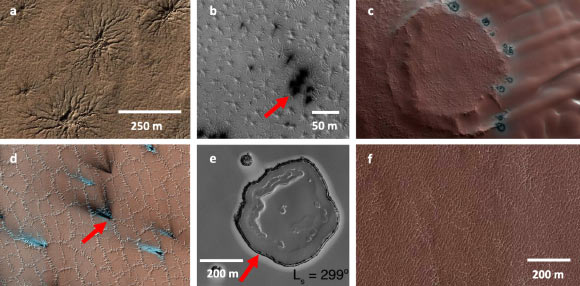
Martian ‘spiders’ are small, dark, spider-shaped features up to 1 km (0.6 miles) across. The leading theory is that they form when spring sunshine falls on layers of carbon dioxide deposited over the dark winter months. Thanks to new experiments, a team of scientists at NASA has, for the first time, re-created those formation processes in simulated Martian temperatures and air pressure.

Examples of the ‘Kieffer zoo’ features proposed to be formed by seasonal carbon dioxide sublimation dynamics on Mars: (a) ‘thin’ spiders within the south polar layered deposits; (b) dark spots on top of a layer of translucent carbon dioxide slab ice covering a cluster of ‘fat’ spiders at Martian ‘Inca City;’ (c) ‘fried eggs’ showing rings of dark dust surrounded by bright halos; (d) patterned ground within the high south polar latitudes with dark oriented fans indicative of wind direction and some bright, white fans; (e) bright halos surrounding Swiss cheese depressions; (f) ‘lace terrain,’ a type of patterned ground suggested to be polygonally patterned ground later scoured and eroded by surface-flowing carbon dioxide gas from the Kieffer model. Image credit: HiRISE / NASA’s Jet Propulsion Laboratory / University of Arizona.
Present-day Mars is a dynamic planet, rich with surface change despite its tenuous atmosphere and cold climate.
In winter, a significant portion of Mars’ primarily carbon dioxide-atmosphere accumulates onto the surface as frost.
In the spring, it sublimes, revealing some morphologies that are unlike anything seen on Earth.
These include dark dalmatian spots and oriented fans, ‘fried eggs,’ gullies sometimes accompanied by dark digitate flows and bright ‘halos’ in spring, dendritic ‘spiders’, sand furrows on active dunes, and growing dendritic troughs.
These features have been detected on loose material around the south pole and on interdune material toward the south polar midlatitudes. However, some minor phenomena have been detected in the north.
Many of these features compose the so-called ‘Kieffer zoo,’ a collection of surface expressions first described in 2003 and proposed to be created by the solid-state greenhouse effect.
“In the Kieffer model, sunlight penetrates translucent slab ice in spring and thermal-wavelength radiation gets trapped, heating the regolith beneath the ice and causing the impermeable ice slab to sublimate from its base,” explained Dr. Lauren Mc Keown of NASA’s Jet Propulsion Laboratory and colleagues.
“Through this process, spiders are proposed to be eroded via high-velocity gas scouring the sub-slab regolith, while fans and variations of spots are strewn on the ice surface, deposited by a plume of dust and gas.”
The study authors were able to create the full cycle of the Kieffer model in a lab and confirm the formation of several types of Kieffer zoo features.
“The hardest part of conducting the experiments was re-creating conditions found on the Martian polar surface: extremely low air pressure and temperatures as low as minus 185 degrees Celsius (minus 301 degrees Fahrenheit),” they said.
“To do that, we used a liquid-nitrogen-cooled test chamber: the Dirty Under-vacuum Simulation Testbed for Icy Environments (DUSTIE).”
“For the experiments, we chilled Martian soil simulant in a container submerged within a liquid nitrogen bath.”
“We placed it in the DUSTIE chamber, where the air pressure was reduced to be similar to that of Mars’ southern hemisphere.”
“Carbon dioxide gas then flowed into the chamber and condensed from gas to ice over the course of three to five hours.”
“It took many tries before we found just the right conditions for the ice to become thick and translucent enough for the experiments to work.”
“Once we got ice with the right properties, we placed a heater inside the chamber below the simulant to warm it up and crack the ice.”
“We were ecstatic when we finally saw a plume of carbon dioxide gas erupting from within the powdery simulant.”
A paper describing these experiments appears in the Planetary Science Journal.
_____
Lauren E. Mc Keown et al. 2024. A Lab-scale Investigation of the Mars Kieffer Model. Planet. Sci. J 5, 195; doi: 10.3847/PSJ/ad67c8
 Print
Print


